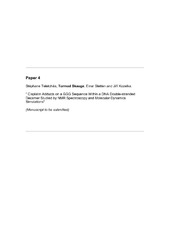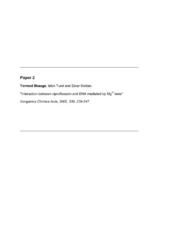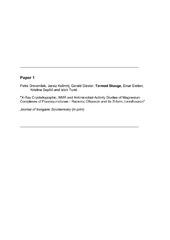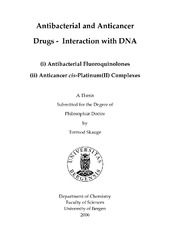| dc.contributor.author | Skauge, Tormod | eng |
| dc.date.accessioned | 2006-07-11T15:53:38Z | |
| dc.date.available | 2006-07-11T15:53:38Z | |
| dc.date.issued | 2006-06-09 | eng |
| dc.identifier.uri | https://hdl.handle.net/1956/1549 | |
| dc.description.abstract | This thesis is concerned with the interactions of drugs with DNA mediated by metal ions. The interactions of two types of drugs were investigated: fluoroquinolone antibacterial agents, represented by ciprofloxacin (cipro), levofloxacin (levo) and ofloxacin (oflo), and the anticancer drug cis-[Pt(NH3)2Cl2] (cisplatin). Fluoroquinolones are highly effective antibacterial agents of which some can be administered orally, thereby having major pharmaeconomical advantages over other antibiotics. Cipro and levo are the most widely prescribed fluoroquinolones and are used against a variety of bacterial infections including treatment of infections of the gastrointestinal, respiratory and urinary tracts, selected sexually transmitted diseases and infections in bones, joints, skin and soft tissues. The primary target for fluoroquinolones is DNA and cellular death is caused by irreversible formation of a ternary fluoroquinolone – DNA – DNA Gyrase complex. However, the molecular mechanisms of action are still largely unknown. Does fluoroquinolone bind preferentially to single-stranded (ss) or double-stranded (ds) DNA ? What is the role of the essential divalent magnesium ion ? What is the binding mode for fluoroquinolones to DNA ? This work attempts to improve the knowledge of this interaction by investigating cipro and levo interactions with DNA in the presence and absence of Mg(II) as well as shedding light on the physico-chemical properties of fluoroquinolones. In paper I, hydrothermal complexes of [Mg(R-oflo)(S-oflo)(H2O)2]·2H2O and [Mg(S-oflo)2(H2O)2]·2H2O were synthesized and studied by x-ray crystallography and NMR. In both structures the anionic fluoroquinolone ligands were coordinated through the keto and carboxylate oxygens forming 1:2 Mg:oflo complexes. The two structures were practically identical, except for the orientation of the oxazine methyl group which lead to shorter distance between layers for the Mg(S-oflo)2 complex. The complexes showed different solution behaviour both in the preparation of and the solvation of the crystals, indicating that the orientation of the oxacine methyl group plays a significant role for the solution behaviour, e.g. selfassociated stacking. In the first high-resolution study of a fluoroquinolone-DNA interaction (paper II), the influence of divalent Mg-ions on the ciprofloxacin affinity for ds-DNA and subsequent implications for the binding mode were investigated. The results showed that ciprofloxacin binds to DNA in both the presence and absence of Mg(II)-ions. In the absence of Mg(II), both major and minor groove binding were observed, while in the presence of Mg(II), the preferred binding site was the minor groove as evident from several cipro-DNA NOE cross-peaks. The Mg(II)-mediated interaction of levofloxacin with two different ds-DNAs was investigated in paper III. Contrary to the observations for ciprofloxacin, levo did not bind to either of the oligomers in the absence of Mg(II). However, in the presence of physiological concentration of Mg(II), levo was found to bind to both oligomers as evident from several NOE cross-peaks. Non-specific binding to both the major and minor groove and interaction with the terminal base pair was observed for both oligomers. Restrained molecular dynamics simulation showed that the minor groove conformation was particularly favourable due to the perfect fit of levo in the minor groove, in accord with the molecular docking results for ciprofloxacin (paper II). One of the oligomers showed levo intercalation between a central GpG step at higher ratios of levo to DNA. The last part of the thesis is concerned with the interaction of the antitumor agent cisplatin with DNA. Cisplatin is the world's most used metal-based anticancer drug and has been in clinical use since 1978. For the first time a structural characterisation of a cisplatin adduct to a ds-DNA containing a GGG sequence has been undertaken. The cisplatin-DNA adduct was investigated using NMR and molecular modelling. The initial G*G*G adduct transformed to a GG*G* adduct through a reversible isomerization reaction. This enabled a comparison of the effects of guanine flanking bases on both the 3´ and the 5´ side of the G*G* cross-link and pyrimidine flanking bases. The results showed that a 3´ flanking guanine has little influence on the G*G* cross-link, while a 5´ flanking guanine induces significant structural perturbations. The context -GG*G*T- was basically similar in structure to the general -pyG*Gpy- context, however the 5´ XpG* step was different in both structure and dynamics. The fact that the isomerization reaction took place suggests that the cisPt - GN7 bond is labile. This would imply that the current models used to describe protein interaction with cisplatin-DNA cross-links should be re-evaluated. | en_US |
| dc.format.extent | 13449692 bytes | eng |
| dc.format.extent | 2331044 bytes | eng |
| dc.format.extent | 834800 bytes | eng |
| dc.format.extent | 4735245 bytes | eng |
| dc.format.extent | 3179965 bytes | eng |
| dc.format.mimetype | application/pdf | eng |
| dc.format.mimetype | application/pdf | eng |
| dc.format.mimetype | application/pdf | eng |
| dc.format.mimetype | application/pdf | eng |
| dc.format.mimetype | application/pdf | eng |
| dc.language.iso | eng | eng |
| dc.publisher | The University of Bergen | en_US |
| dc.relation.haspart | Paper 1: Journal of Inorganic Biochemistry 100(11), Drevenšek, P.; Košmrlj, J.; Giester, G.; Skauge, T.; Sletten, E.; Sepčićm K.; Turel, I., X-Ray Crystallographic, NMR and Antimicrobial Activity Studies of Magnesium Complexes of Fluoroquinolones - Racemic Ofloxacin and Its S-form, Levofloxacin, pp. 1755-1763. Copyright 2006 Elsevier. Accepted version. The published version is available at: <a href="http://dx.doi.org/10.1016/j.jinorgbio.2006.06.011"target=_blank>http://dx.doi.org/10.1016/j.jinorgbio.2006.06.011</a> | en_US |
| dc.relation.haspart | Paper 2: Inorganica Chimica Acta 339, Skauge, T.; Turel, I.; Sletten, E., Interaction between ciprofloxacin and DNA mediated by Mg2+-ions, pp. 239-247. Copyright 2002 Elsevier. Published version. The published version is also available at: <a href="http://dx.doi.org/10.1016/S0020-1693(02)00933-7"target=_blank>http://dx.doi.org/10.1016/S0020-1693(02)00933-7</a> | en_US |
| dc.relation.haspart | Paper 3: Skauge, T.; Sletten, E., 2006, Antibacterial Fluoroquinolone Agents - Interaction with DNA. Draft | en_US |
| dc.relation.haspart | Paper 4: Chemistry - A European Journal 15(45), Teletchéa, S.; Skauge, T.; Sletten, E.; Kozelka, J., Cisplatin Adducts on a GGG Sequence Within a DNA Double-stranded Decamer Studied by NMR Spectroscopy and Molecular Dynamics Simulations. Published as: Cisplatin Adducts on a GGG Sequence within a DNA Duplex Studied by NMR Spectroscopy and Molecular Dynamics Simulations, pp. 12320 - 12337. Copyright 2009 Wiley-VCH Verlag GmbH&Co. Draft. The published version is available at: <a href="http://dx.doi.org/10.1002/chem.200901158" target="_blank">http://dx.doi.org/10.1002/chem.200901158</a> | en_US |
| dc.title | Antibacterial and Anticancer Drugs - Interaction with DNA | en_US |
| dc.type | Doctoral thesis | |
| dc.rights.holder | Tormod Skauge | en_US |
| dc.subject.nsi | VDP::Matematikk og Naturvitenskap: 400::Kjemi: 440 | nob |




